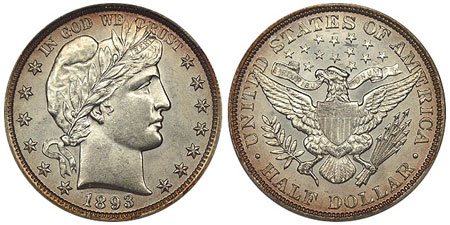Guide to U.S. Barber Half Dollars
Together with the similarly designed dime and quarter, the Barber Half Dollar was introduced in 1892, replacing the long-running Seated Liberty motif. The new series is named for its designer Charles E. Barber, who had served as the sixth Chief Engraver of the United States Mint. The Barber Half Dollars would be produced each year from 1892 to 1915 at the Philadelphia and San Francisco Mint, with some dates also struck at New Orleans and Denver. The series contains one famous variety and a number of conditionally scarce coins.

The Barber Half Dollar shares its origin story with the Barber Dime and Quarter series. After more than five decades of use for the Seated Liberty design, United States Mint Director James P. Campbell began to advocate for a change. This eventually led to legislation which granted the Treasury Department authority to alter coin designs once they had been use for at least 25 years.
Following the passage of the legislation, two contests were held in order to select new designs for the three silver coin series. The first contest included ten prominent artists, while the second was open to the broader public. After both contests failed to produce a suitable design, the task to redesign silver coinage fell to Charles E. Barber. He had been on the panel in charge of judging the contest entries, and all along it may have been his intention to create the designs himself.
Obverse Design
Barber’s obverse design features a bust of Liberty, facing right and wearing a Phrygian cap. A wreath of laurel and a band inscribed LIBERTY adorn her hair. The inscription IN GOD WE TRUST appears above, and the date below. Thirteen stars are present, arranged six to the left and seven to the right. The designer’s initial “B” appears at the truncation of the neck.
Reverse Design
The reverse design is based on the Great Seal of the United States. An eagle appears with a shield at its breast, wings spread, and an olive branch and bundle of arrows in its talons. A ribbon inscribed E PLURIBUS UNUM is held in the eagle’s beak, and thirteen stars are placed overhead. The inscriptions UNITED STATES OF AMERICA and HALF DOLLAR appear surrounding.

